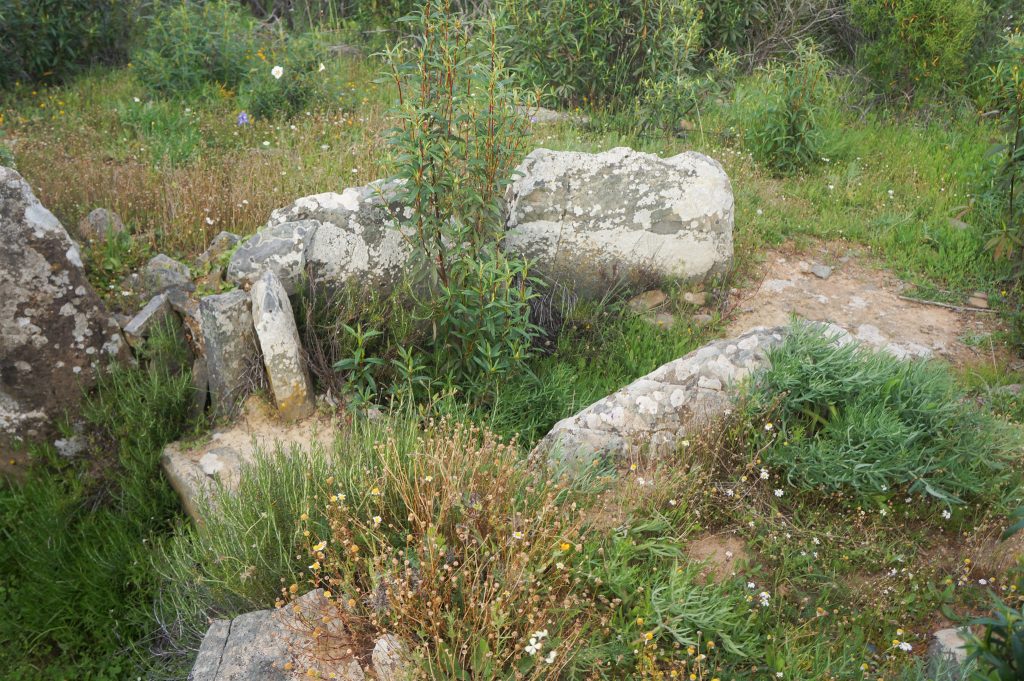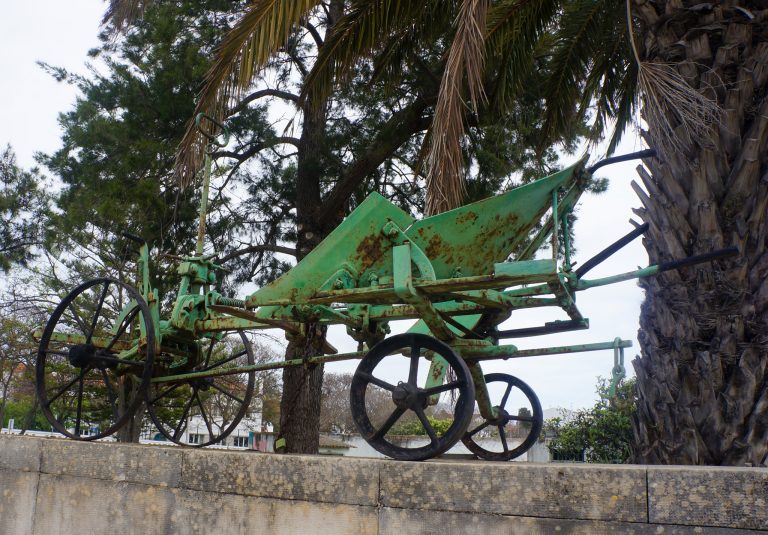Cachopo, the windmill, wild flowers, the earthstar and the stones
Some days I just want to bottle moments of joy. That not being possible, on International Women’s Day 2024, I decided to start recording the events of a magical day from earlier in the week. Four women had a mission, an electric car, which I drove and the sun on our backs. You could call our mission one of spirit – that is we wanted to find ancient stones. We are women who meet together to meditate and create art. We feel connected to each other and the earth, so for me our exploration was about deepening our relationship with nature. But also the opportunity for a “jolly out” together.
I thought I knew the general location of the stone circle, near the village of Cachopo in the district of Tavira. I guessed that’s because there is only one road in and out of the village and another road heading west which the stones could be on. I hoped we would locate them fairly easily. I was wrong, but never mind about that. The adventure was not thwarted and perhaps that’s all I need to say about getting lost and failure.
As we entered Cachopo we stopped to look at the old Windmill. I wrote about its workings in an article for the Portugal Resident and this Blog, 14 years ago nearly to the day. If you want to know about this windmill see the link at the end. Social history is a life-long passion for me. How people lived, what they believed and how they communicated and survived often occupy my thoughts. The ancient is ever present in Portugal.

Leaving the Mill with a bunch of new photos, we drove perhaps for 20 minutes and stopped to take in the fields of vibrant green glory, some occupied with yellow upright flowers possibly lupin (used as a manure crop) next to a little brook. Poppies sat prettily and content on the bank of the water.



As we entered the village of Mealha we discovered a few ruins of the “Casas Circulares” (Round houses) or “Palheiros” (barns). These are pre-historic stone houses that have been used by farmers and dwellers for thousands of years. These buildings were mostly used for housing animals and feed. The structures are made of slate, with a diameter of approximately 4-6 metres and about a 1.5 metres in height with a high wooden poled roof. The round walls can be as high as 2.5 metres. Nearby was an information board which shared that an 80 year old woman from “Barranco do Velho” remembers her grandparents lived in one of the roundhouses when they were children in 1948, the roof being covered with reed from the river.



We entered the tiny village of Mealha with a crazy thought that there might be a restaurant, but no there was only a place where it was difficult to turn around. So the village had to suffer at least 5 minutes of bleeping because of my attempt at reversing with two soul sisters at either side guiding the process.
Sadly there was no stone circle so we returned to Cachopo not disheartened because the thrill of the beauty surrounding us was enough and lunch was calling us. After a no menu and one option delicious lunch in one of the two open restaurants in Cachopo we planned to walk around the village via the church. Passing the museum there was a delightful and unexpected surprise of two policemen and roadworks, no that was not the surprise, what I mean is the Museum was open and we visited with Dona Otelia the guide.
Over the previous three weeks I had called the museum on various numbers three times without reply to ask the opening times. Never mind, it was open and after filling the small space with our presence, Dona Otelia explained the nature of flax as a plant and linen as a creation.
“Flax is a natural plant fiber. It is a bast fiber, which means it comes from the stem of a plant. Linen is made out of flax, though sometimes the term “linen” is used incorrectly to label fabrics of other fibers that have a similar look and feel. While linen and flax are used interchangeably, flax can be found in other textiles as well, like lace and damasks. Flax is considered a more rare, high quality product and represents less than 1% of all textile fibers consumed worldwide.”
CFDA.com – Council of Fashion Designers of America




You can purchase linen and woollen items in the tiny museum which is stuffed to the rafters with history.
Dona Otelia gave us the gift of an English leaflet with a map. On this precious document was the name and possible location of the stones.
Cachopo at the last census in 2021 had a population (mostly over 65) of 451 inhabitants. Lockdown reduced that number as people moved away. Donna Otelia shared that only 100 people now live in the village which is compact with a few modernised cottages amidst decaying former homes. There are touches of delight in the decay.




After enjoying the view from the Santo Estevao Church of more “palheiros,” we headed back down the same road to make a further search for the stones.
We parked in a small hamlet of two or three houses and wandered down and up a gravel track till we came to what looked like a derelict old mill.

As we approached the mill, one of my soul sisters pointed at what looked like a tortoise on the track and we spent a few moments wondering what it was and what we should do about it. The consensus was that it was a fungus. We did not interfere with its presence. We continued along the track with no sign pointing the way to our stones, but what I did notice was a kind of carpet of flowers and what might be a trail. So we followed the trail through the wild fire hazard of cistus with its oily leaves to a small opening and there was the funeral circle with the stones. It looked untended and I worry about sharing the location as it feels like a sacred place. I certainly felt movement in my legs as though energy was rising from the earth.






I would like to draw or meditate there and I may go back soon, either alone or with friends. We spent a few moments in silence and held hands as we took in the ancient.
The researcher Anthony Sheldon in the JASO publication about death rituals notes, “functional utility begins with nature.” The publication includes a useful bibliography for further study. There is some discussion of witchcraft in the reviews at the end.
I have also included further research to death rituals in Portugal in a link below.
And now to the essential part of the story:
The Megaliths of the Mouras Encantadas
Henna Lindström of the University of Helsinki writes in her 2014 thesis of folktales and legends that grew up around the supernatural makers and guardians of Portuguese dolmens (anta in Portuguese):
“Mouras Encantadas are supernatural beings in Portuguese folklore. They live in megalithic tombs and guard the entrance to the world beyond.”
Lindström recalls stories from parts of Europe about the Mouras Encantadas, as the mysterious women are called in Portugal. They protect the dolmens.
“A dolmen (/ˈdɒlmɛn/) or portal tomb is a type of single-chamber megalithic tomb, usually consisting of two or more upright megaliths supporting a large flat horizontal capstone or “table”. Most date from the Late Neolithic period (4000–3000 BCE) and were sometimes covered with earth or smaller stones to form a tumulus (burial mound). Small pad-stones may be wedged between the cap and supporting stones to achieve a level appearance. In many instances, the covering has eroded away, leaving only the stone “skeleton”.” Wikipedia

Photo attribution – Poulnabrone dolmen, the Burren, County Clare, Ireland
Frank Chandler, CC BY-SA 4.0, via Wikimedia Commons
Wikipedia notes, Mouras Encantadas are maidens who guard castles, caves, bridges, wells, fountains, rivers, and treasures.
The legends describe Mouras Encantadas as young maidens of great beauty or as charming princesses who are “dangerously seductive.” They are considered shapeshifters. They appear as guardians of the pathways into the earth and frontiers where it was believed that the supernatural could manifest itself.
Our stones were clearly typical of other dolmen structures.
“The passage tombs, which consist of one or more chambers and a corridor covered in earth or stone, are known all over Europe. Prehistoric peoples placed their dead in the tombs between 6000 and 2000 BC, the Neolithic era,” – some of the tombs feature paintings illustrating the tombs purpose.”
“Two famous passage graves are Maeshowe in Scotland and Newgrange in Ireland.”
Ancientorigins.net
For the winter solstice recently I watched the magical online streaming of the sunrise at Newgrange. I will write about Newgrange in June after a planned trip to Ireland to discover some ancestors. There is so much more to write about the Mouras Encantadas so I may write a separate article soon. In the meantime see the links below.

Final discoveries
Walking slowly back to the main track, we noticed that buried in the cistus was a sign that looked burnt and damaged, but some words were visible. I hope Tavira Council repairs the sign as this is a place of wonder and it needs some care and protection.
As we walked down the track back to the car, we saw a second tennis ball sized fungus and this time I searched my plant app and discovered the name of the beauty. It is an Earthstar mushroom. It is said to be edible and has healing properties. The spores are sprayed when the fungus opens into a star-like shape. None of us had seen anything like it before. I am not sure of the genus of our mushroom, possibly Astraeus hygrometricusas as they are seen in Iberia but the photo below indicates what it may look like when open. Hence the name earthstar. “The Blackfoot of North America called the fungus “fallen stars,” considering them to be stars fallen to the earth during supernatural events.”
Look at the links below to discover much more about the nature of the mushroom.
I am so grateful to have been with women friends when making these discoveries.

Photo attribution
Diana Marcela Rocabado Reyes, CC BY-SA 3.0, https://commons.wikimedia.org/w/index.php?curid=5228798

All images Sue Hall ©2024
Links for further discovery
Cachopo
https://cm-tavira.pt/site/conhecer-tavira/cachopo/
https://pt.wikipedia.org/wiki/Cachopo
http://www.jf-cachopo.pt/index.php/o-patrimonio/arquitectonico/74-a-igreja-de-cachopo
Windmills and Watermills
From wind to the production of flour – The Cachopo windmill – Cachopo moinhos de vento
https://suehall.net/?p=140
The tide waits for no miller
https://suehall.net/?p=197
Cistus – Wild rose
https://en.wikipedia.org/wiki/Cistus
Megalithic
https://www.megalithic.co.uk/article.php?sid=57895
Newgrange
https://www.newgrange.com
Winter solstice – sunrise
https://www.youtube.com/watch?v=BAfZLCVyEhs
Knowth and Newgrange
https://www.youtube.com/watch?v=2ldH0a_LsX4
Earthstar
https://en.wikipedia.org/wiki/Astraeus_hygrometricus
https://en.wikipedia.org/wiki/Geastrum_triplex
https://masteryourmagic.com/travel/earth-star-chakra/
Death rituals in Portugal
https://www.anthro.ox.ac.uk/sites/default/files/anthro/documents/media/jaso14_1983.pdf
https://www.ancient-origins.net/myths-legends-europe/legends-say-mysterious-women-built-megaliths-portugal-003176
Dolmens
https://en.wikipedia.org/wiki/Dolmen
Henna Lindström – University of Helsinki
https://www.academia.edu/12656316/Casas_das_Mouras_Encantadas_A_Study_of_dolmens_in_Portuguese_archaeology_and_folklore_Masters_thesis_2014
Mouras Encantadas
https://en.wikipedia.org/wiki/Enchanted_Moura
Other research related to death rituals in Portugal
https://www.academia.edu/4079895/Rituals_and_Death_Cults_in_Recent_Prehistory_in_Central_Portugal_Alto_Ribatejo_Portugal_
https://www.anthro.ox.ac.uk/sites/default/files/anthro/documents/media/jaso14_1983.pdf


Cachopo’s a beautiful village, especially at this time of year. I believe we saw the dolmen a good number of years ago, but I wouldn’t be able to find it now.
Hi Johanna, Thanks for your comment. Yes, we chose a warm and sunny day to visit. I would love to find more dolmens in Portugal. Kind regards, Sue